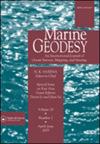用UASs对容器进行水平校正
IF 1.4
4区 地球科学
Q2 GEOCHEMISTRY & GEOPHYSICS
引用次数: 0
摘要
摘要从船载声纳到惯性测量单元和全球导航卫星系统等系统的偏移矢量知识对于精确的海洋测绘应用至关重要。传统的测量方法,如使用激光扫描仪或全站仪,用于可靠地确定专业船只偏移距离。然而,对于正在收集自愿水深数据的有机会的船只,考虑可能耗时较少、成本较低或不涉及将船只带入干船坞的调查方法是有益的。因此,本文探索了两种满足水平校准容器标准的替代方法。无人机系统(UASs)用于在船只停泊在浮船坞时,使用运动摄影测量结构和航空激光雷达对船只进行水平校准。通过将无人机方法获取的船只上目标之间的水平距离与多个地面实况源(勘测级地面激光扫描和玻璃纤维胶带测量)进行比较,获得了与地面实况水平偏差的估计值。通过使用地面控制点,所研究的方法能够实现厘米级的水平偏差。本文章由计算机程序翻译,如有差异,请以英文原文为准。
Horizontal Calibration of Vessels with UASs
Abstract Knowledge of offset vectors from vessel mounted sonars, to systems such as Inertial Measurement Units and Global Navigation Satellite Systems is crucial for accurate ocean mapping applications. Traditional survey methods, such as employing laser scanners or total stations, are used to determine professional vessel offset distances reliably. However, for vessels of opportunity that are collecting volunteer bathymetric data, it is beneficial to consider survey methods that may be less time consuming, less expensive, or which do not involve bringing the vessel into a dry dock. Thus, this article explores two alternative methods that meet this criterion for horizontally calibrating vessels. Unmanned Aircraft Systems (UASs) were used to horizontally calibrate a vessel with both Structure from Motion photogrammetry and aerial lidar while the vessel was moored to a floating dock. Estimates of the horizontal deviations from ground truth, were obtained by comparing the horizontal distances between targets on a vessel, acquired by the UAS methods, to multiple ground truth sources: a survey-grade terrestrial laser scan and fiberglass tape measurements. The investigated methods were able to achieve horizontal deviations on the order of centimeters with the use of Ground Control Points.
求助全文
通过发布文献求助,成功后即可免费获取论文全文。
去求助
来源期刊

Marine Geodesy
地学-地球化学与地球物理
CiteScore
4.10
自引率
6.20%
发文量
27
审稿时长
>12 weeks
期刊介绍:
The aim of Marine Geodesy is to stimulate progress in ocean surveys, mapping, and remote sensing by promoting problem-oriented research in the marine and coastal environment.
The journal will consider articles on the following topics:
topography and mapping;
satellite altimetry;
bathymetry;
positioning;
precise navigation;
boundary demarcation and determination;
tsunamis;
plate/tectonics;
geoid determination;
hydrographic and oceanographic observations;
acoustics and space instrumentation;
ground truth;
system calibration and validation;
geographic information systems.
 求助内容:
求助内容: 应助结果提醒方式:
应助结果提醒方式:


